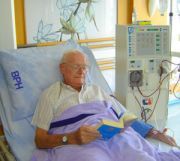Primary Care Physicians Are on the Front Lines in the Battle against Chronic Kidney Disease
Early diagnosis by primary care physicians and aggressive treatment are essential to slowing the epidemic of kidney and cardiovascular disease.

Robert Stanton, MD, associate professor of Medicine, Harvard Medical School, Chief of Nephrology, Joslin Diabetes Center, began his “Chronic Kidney Disease” session at the 2013 Pri-Med East Conference and Exhibition, by presenting some astounding data. He first showed a map of the number of patients on dialysis in 1992 (it was sparse); he then showed a map of dialysis in 2002 (it was dense, and all over the world), eliciting an audible gasp from the audience at the increase. “The numbers keep rising,” he said.
Stanton said he likes to use dialysis incidence rather than test results, as dialysis is countable and cannot be argued with. He said that Kidney disease “is not an equal opportunity player:” American Indians, Hispanics, and African-Americans are all at higher risk.
“What are the consequences? They get dialysis; they get a transplant; or they die. Those are the options,” said Stanton. He said that as a specialist, he can’t have as great an impact as a primary care physician can when it comes to alleviating this situation because he doesn’t diagnose patients; it’s up to PCPs to “recognize and diagnose early and often.”
Stanton presented some sobering statistics, noting that about 14% of the US population has CKD. Most CKD patients die of heart disease before reaching end-stage renal disease (ESRD), as there is a very close association of CKD and cardiovascular disease (CVD)—when GFR (glomerular filtration rate) declines and/or urine albumin levels rise, cardiovascular events and mortality rise. About 593,000 patients are on dialysis (414,000) or have a kidney transplant (179,000). There are 87,000 patients on the transplant wait list. Death rates are 20%/year for dialysis patients. The number of ESRD patients rises about 1-3% each year. Stanton noted that Medicare spends about $30 billion annually on CKD (.2% of the population spends 6.1% of the Medicare budget!).
Drivers of kidney disease are: diabetes mellitus, hypertension, and glomerulonephritis. Recognition and diagnosis should be done by GFR, albuminuria/proteinuria, and urinalysis tests; these must be tested for to have an impact on CKD. Stanton emphasized that using creatinine alone to diagnose kidney disease means the clinician doing so will probably miss it. And, as GFR changes with age, physicians must use a formula that factors in age, sex, and race—MDRD (Modification of Diet in Renal Disease) or CKD-EPI (Chronic Kidney Disease Epidemiology Collaboration).
“The urine dip stick is not an effective diagnostic tool!” Stanton proclaimed. He said urinalysis is also important for diagnosis, and advised using a spot urine specimen to measure the albumin/creatinine ratio. “Only diagnosis and intervention by all of us here can make a difference,” he said.
Treatment of CKD involves: education, diet, exercise, and weight loss. Treatment goals should be: blood pressure (BP) <130/80, lowered urine albumin, smoking cessation, and, if the patient is diabetic, tight glucose control (A1c<7.0%). Interestingly, Stanton said that blood pressure measurements taken in the physician’s office are often recorded and used as a baseline despite ”White Coat Hypertension” and bad routine office practices. However, studies show that home blood pressure measurements are more accurate. Stanton also recommended using the home blood pressure to diagnose and monitor blood pressure. Blood pressure recommendations for patients with CKD are somewhat complex: <130/80, <125/75 if >1g of urine protein, and avoid <115 systolic if diagnosed with CVD.
In addition to blood pressure control, there is also a role for RAAS (renin angiotensin aldosterone system) inhibitors, blood sugar control if diabetic, ACE (angiotensin converting enzyme) inhibitors, and ARBs (angiotensin receptor blocker). Stanton presented several studies with recommendations; and admitted that they contradicted each other (eg, Losartan, ONTARGET, CHARM). The choices and combinations of drugs and conditions must be carefully assessed by the treating physician.
Stanton also discussed the role of a low-protein diet (<0.8 g/kg/day), which has been shown to be effective in animal studies. Although high protein intake is associated with worsening renal disease, low-protein diets have not been routinely shown to be effective in humans (because it is very hard to stay on a low protein diet?). He concluded by saying, ”I don’t think it is very useful; it’s not effective in humans, just animals.”
At the end of the session, Stanton told the audience, “You’re the ones that can make a difference,” emphasizing that early diagnosis and aggressive treatment are essential to slow the epidemic of kidney and cardiovascular disease.